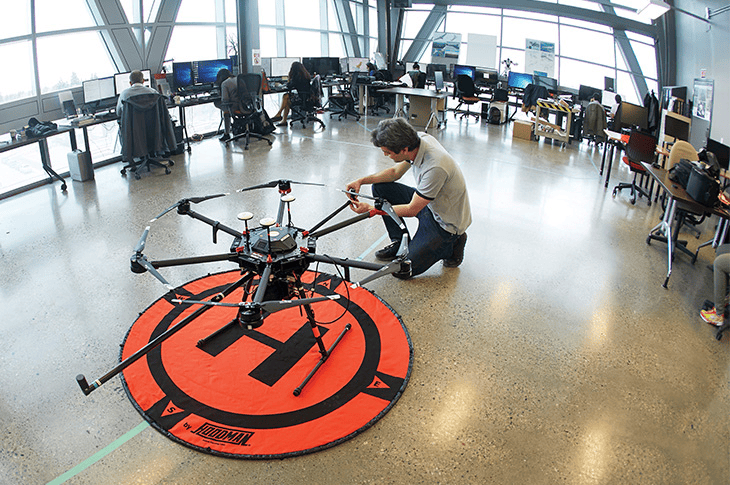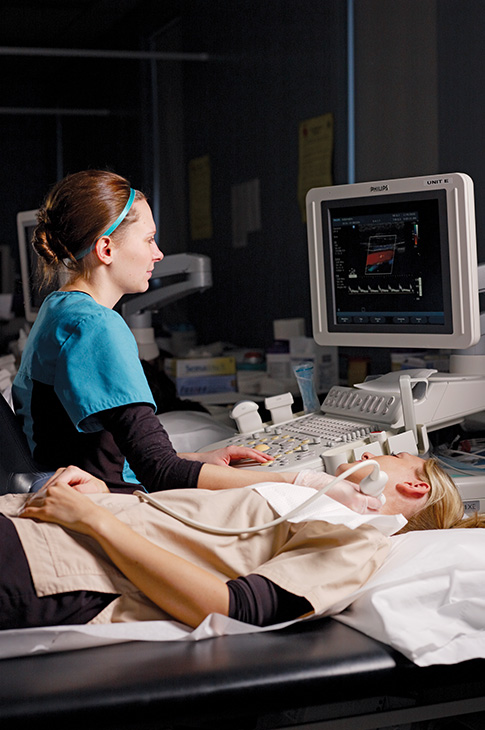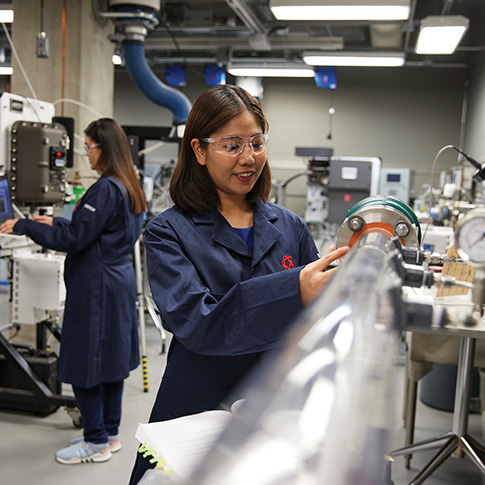The promise of Real Futures all started thanks to one man’s monumental gesture.
With his gift of $30 million in 2019, Calgary business leader and philanthropist David Bissett empowered SAIT to equip students with the advanced digital and technological expertise industry will inevitably require.
Bissett’s investment supercharged SAIT’s tools and teaching capabilities by establishing the School for Advanced Digital Technology (SADT). It also seeded Real Futures, the major SAIT fundraising campaign that has so far raised $100 million of its $150-million target. It’s money that’s changing what, how and who SAIT teaches — including two new learning locations.
A sense of place
SADT opened its doors to students in September 2020 with a wide range of tech-focused programs. In January 2022, SADT merged with SAIT’s School of Information and Communications Technologies, combining their strengths to offer programs in media and information technologies.
And SADT continues to drive new connections and ideas with SAIT Downtown, a 19,000-square-foot facility in the city’s core. Located on the first and second floors of Barclay Centre (444 - 7 Ave SW), it is designed to house, support and ultimately leverage programming for SADT and other SAIT schools.
This hyperextension of campus brings together cutting-edge tools and technologies in a space designed to invite experimentation, entice collaboration, and prepare students and industry to thrive in a digital economy.
Imagine an immersive experience called the Cyber Range — anticipated to launch this fall — where simulated cyberattacks will offer hands-on, risk-free critical response practice to youth, students, workplace professionals and industry partners. This is the kind of real-future preparedness SAIT Downtown is incubating.
On the ground floor of the same building is another showpiece SAIT facility: The Tastemarket Canadian Kitchen. Established in 2017, it’s a living classroom where SAIT culinary students gain first-hand experience in a working urban eatery.
 Photo: Cheng Geng Chiang via Getty images
Photo: Cheng Geng Chiang via Getty images
“A sense of place has a really powerful way of informing what you teach and how you teach,” says the Dean of the School of Hospitality and Tourism, James Overall (HRA ’01). “It feels different to be on a downtown campus than on our main campus. It’s different clientele. It’s different target markets. There are different needs and different expectations.”
Now picture what a satellite campus in one of the world’s most iconic travel destinations could mean to hospitality and tourism students.
Thanks to a $30-million gift in November 2024 from the Banff-based Wim and Nancy Pauw Foundation, announced in tandem with a strategic partnership with the YWCA Banff, SAIT now has the unprecedented opportunity to teach, learn and grow with and within the Bow Valley Corridor.
“This is really the first step of us having an intentional presence in the area,” says Overall. “To embed ourselves in the region and become a part of the community in a purposeful way.”
The YWCA Banff received a portion of the funding to convert some of its older hostel rooms to student dorms, and will provide space for classrooms and various programming over two floors of its building, beautifully located right on the Bow River. The student accommodations piece is critical, given the scarcity of affordable housing in the townsite. It’s truly a game changer in terms of helping shape SAIT’s vision for a new school in Banff National Park.
“We’ll have the ability to deliver a mix of residency and non-residency programming,” says Overall, with an eye to building out entirely new program offerings as well as weaving in existing programs along with Banff study tours and weekend excursions.
It will be called the Wim Pauw Centre for Hospitality and Tourism Located at the SAIT Banff Campus — and Overall expects it will launch in the fall of 2026 with a one-year post-diploma certificate in Hospitality Tourism Management. Its students will spend four months at the main Calgary campus, followed by four months studying in Banff, and then another four months living and working in the local industry. The Centre will be open to receive these students in January 2027.
Immersive learning has always been SAIT’s hallmark and this will be an exceptional immersive learning environment.
“We’ll be teaching in one of the world’s most acclaimed tourist destinations — which happens to be Canada's oldest national park. That creates all sorts of really fascinating dynamics like sustainable tourism and the tensions between that and growth,” says Overall. “We’ll be living and breathing this stuff every day.”
The three-way partnership between the Pauw Foundation, the YWCA Banff and SAIT is deeply community-centric. “We found a place where our missions overlap and we’re all really excited about the great things that are going to come from this over the long term,” says Overall.
“Once SAIT becomes part of the community — integrated with industry and the region at large — this is going to open up opportunities we haven’t even thought about. There’s no doubt in my mind this is going to be a transformative next step.”
Teaching with technology

In a world with an abundance of leading-edge technology, it’s not always easy for educators to know which new technologies to employ in the classroom or how they will enhance student learning.
And in an institute rooted in hands-on and applied learning, it’s generally agreed that the best way to work through such decisions is to ask questions and experiment.
Dr. Bill Rankin is an educational theorist, designer, speaker and researcher. In 2023, SADT invited him to be an Expert in Residence, helping instructors redefine their teaching practices.
“I met with the various Deans and talked with a whole bunch of folks from all over campus,” Rankin says. Those initial conversations led to the creation of the Teaching Innovators Program.
“It emerged from three reoccurring themes identified by engaged instructors: how to incorporate new technologies, how to answer questions and how to solve problems.”
In the first year, 40 instructors volunteered to participate in the program. To date more than 75 have queried, applied and tested their ideas. A handful of the projects with particularly promising outcomes have now moved into a second, SAIT-funded phase of experimentation with an eye to potential inclusion in program curricula.
“My goal is to serve as a resource for the instructors,” Rankin says.“To help them find ways to answer their questions for themselves and develop some expertise they can share with their peers. The teachers are the innovators.”
A lot of those questions revolve around the use of AI in the classroom (“Is it okay?”), student engagement, and experiential learning (how to achieve and/or sustain it in different environments).
Effective use of technology may be integral to the program, but Rankin explains the focus should never be on the tech itself but rather on teaching and learning goals.
Citing the old saying, he explains, “If the only tool you have is a hammer, everything starts to look like a nail. If you’re determined to do something with tech, you will do something with it. But unless you ask some key questions, it won’t necessarily be something productive or real or useful. It will just be a nail.
“Ask what it is you want to give your students — what experience, what knowledge, what connections to their community? Once you decide that, then the tech becomes clear.”
Sometimes the solution will be technology. Sometimes it’s more interpersonal. Rankin gives the example of a project by SADT Radio News instructor Laura Knop-Wright (CTSR ’81) investigating whether AI can generate podcast material. She determined it could not — because AI simply doesn’t have the kind of human insights necessary for storytelling.
Storytelling provides context for understanding and recall. “We remember things better from an experience than we do from, say, reading a list of elements,” says Rankin. “A story, an experience; human connection carries a lot of meaning for people and they will carry the information with them longer as a result.
“So as teaching innovators, we might want to think about the pile of information we want to share — and how best we can transfer it into experiences and stories.”
Where universities focus on theory, polytechnics are hard-wired for “learning by doing.” Having real-world context naturally integrates information into stories and experiences. Rankin says this is what makes SAIT particularly well-positioned as a teaching and learning environment.
 “Generally, we ask for a preference,” says Brown, “but sometimes the student’s preferred location just isn’t an option.” Relocation costs fall to the student and these — on top of the normal day-to-day costs of living while working full-time without pay — can create real financial hardship.
“Generally, we ask for a preference,” says Brown, “but sometimes the student’s preferred location just isn’t an option.” Relocation costs fall to the student and these — on top of the normal day-to-day costs of living while working full-time without pay — can create real financial hardship.
“Practicum poverty is about not having the financial means to do the required practicum component of their studies,” says Brown. It’s a growing problem: “Ten years ago it wasn’t as big an issue as we’re seeing now. I think just because everything — tuition, transportation, accommodation, groceries — costs so much now.”
The Co-operative Education and Work-Integrated Learning Canada (CEWIL) iHub Bursary Program has been a lifeline for many. Since 2023, CEWIL has contributed $995,000 in support of 576 SAIT students. Of those, 300 were in the School of Health and Public Safety.
“This funding really does make a difference in a student’s ability to be successful in their practicum,” says Brown. “We’ve heard from lots of the recipients that it lowered their stress level because they didn’t have to worry about how to put food on the table or how to buy a textbook — those types of things. It gave them the opportunity to focus on their studies.”
These practicum placements are also really important to rural communities that often struggle to find talent. “One of the best ways to recruit people is to bring them into your place of work,” Brown says. And in rural healthcare facilities, students tend to benefit from broad exposure to and collaboration with multiple healthcare professionals — truly a hands-on, foot-in-the-door-type WIL opportunity that serves both students and the community at large.
Digital collaboration across campus
Collaboration is a force. In this world of technological breakthroughs and expedited exponential change, none of us can afford to go it alone. Industry partnerships have always helped SAIT, the student body and the industry itself keep pace with new and emergent ways. Expanded collaboration between SAIT’s academic schools is a logical progression.
In 2023, SAIT received a gift of $1.58 million from Spartan Controls intended to accelerate instrumentation and automation programming at the MacPhail School of Energy (MSE) — and to encourage all SAIT schools to tap into the advanced technology and expertise in SADT.
Just one example: SADT is helping introduce digital twin technology to facilitate lab work in the MSE.
A digital twin is essentially a virtual copy of a physical asset or system. Used for simulation, analysis and control, it’s a true-to-form-and-function representation of the real thing and exists in real time. It’s dynamic and responds to changing inputs and conditions, just like its actual nuts-and-bolts twin.
Digital twins can themselves be replicated, side by side, to fill a lab — eliminating the need for instructors to schedule everyone’s turn on a single, expensive asset.
“It’s an enrichment in what our students are currently doing,” says Mark Tarrant, an Industrial Automation instructor with the MSE. “Now we can have them working on the exact same thing without any comparative risk. They can make mistakes as they learn without any real-time repercussions of the actual process.”
The technology also helps SAIT adapt to change more quickly because, as industry advances, software upgrades to digital twins are quick and more cost effective than physical upgrades to equipment like the on-campus power plant.
The MSE’s chemical labs will be the first to be connected via digital twin technology, but this same technology will soon be supporting its water lab and the Distributed Control System lab as well.
“If we have the ability to do a digital twin, why not serve as many disciplines and labs as possible using this technology,” Tarrant says.
This kind of strategic interdisciplinary collaboration within and between SAIT’s academic schools will accelerate learning and promote a better, bigger-picture understanding of the inherent interconnectivity found in industrial network infrastructures.
“By digitally connecting the labs across the Environmental Technology, Chemical Engineering Technology, and Instrumentation Engineering Technology programs, we are breaking down long-standing silos,” says Dale Hansen (BA ’88), Dean, MacPhail School of Energy.
“This digital integration is enabling real-time data collection that directly enhances curriculum delivery — making our courses more realistic, interdisciplinary and aligned with real-world applications.”
The future of who we teach


The Real Futures campaign is aptly named. Its emphasis on transforming what and how SAIT teaches will ensure industry has the talent it needs — but there’s an equally vital emphasis on shaping the future of who we teach: the student body.
Student awards in the form of scholarships and bursaries are a clear and direct means of improving access to education across a growing range of communities, removing financial barriers and supporting student success.
“Awards are something our donors are really committed to,” says Donna Lambert, Manager of Advancement Services and Student Awards. “Three years ago, our annual disbursement was nearly $6 million. This year, we project it will be over $9 million.”
That’s a growth rate of more than 30% with 5,800-plus awards in total. “We had 75 new awards just last year; 70 to 80 the year before.”
Individual donors represent the mainstay of SAIT’s Awards Program, with many gifts taking the form of endowments that pay out year after year. “An endowed award is in perpetuity,” says Lambert. “We don’t touch the principal — just the interest, and so the value changes as the award grows.”
She also cites a trend where industry is increasing financial support for student awards in their specific sectors.
One example is TECTERRA, a leader in the geomatics industry. In 2023, they expanded their funding for scholarships at SAIT and three other Alberta post-secondaries.
“TECTERRA recognizes that success in the industry starts with the development, training and retention of highly qualified professionals,” Lambert says. “In addition to supporting capital upgrades and program funding, their vision is to encourage growth in the geospatial industry. Every year, the TECTERRA Geomatics Award is funding most or all tuition costs for nine SAIT Geomatics Engineering Technology students.”
That funding is desperately needed.
“Our student population is slightly older than a regular university model. We have lots of people who come back for a second program, or to reskill,” Lambert says.
She explains how SAIT’s unique student demographics might be particularly prone to financial barriers, such as older students coming to SAIT with adult life circumstances. They may have families to support. They’re living off student loans and juggling multiple part-time jobs while attending school. Many are paying market rent, or a mortgage.
“Apprentice students are often from out of town since there are only a couple places that offer this type of training in Alberta,” Lambert says. “They don’t really earn much in their first or second year. It’s not uncommon for us to hear that apprentices are sleeping in their cars.”
International students experience a whole other layer of complexity and the unknown when it comes to finances and budget planning. Unanticipated expenses, inflationary pressures, volatile currency conversion rates — the list goes on.
Thankfully, so do the opportunities to support — and Real Futures is one more SAIT strategy for increasing access to education among diverse and deserving groups.
Lambert regularly receives thank-you notes from students who have been granted an award or bursary. Recently she received this note: “Thank you for believing in people’s dreams. Sometimes people just need to know they have support and at least one person who believes in them. There’s no limit to what someone can achieve when they have that encouragement. Thank you for seeing me.”

Like what you are reading?
Find more stories from past, present and upcoming issues of LINK magazine!

Oki, Âba wathtech, Danit'ada, Tawnshi, Hello.
SAIT is located on the traditional territories of the Niitsitapi (Blackfoot) and the people of Treaty 7 which includes the Siksika, the Piikani, the Kainai, the Tsuut’ina and the Îyârhe Nakoda of Bearspaw, Chiniki and Goodstoney.
We are situated in an area the Blackfoot tribes traditionally called Moh’kinsstis, where the Bow River meets the Elbow River. We now call it the city of Calgary, which is also home to the Métis Nation of Alberta.
